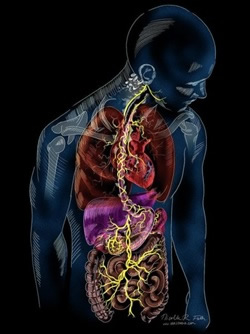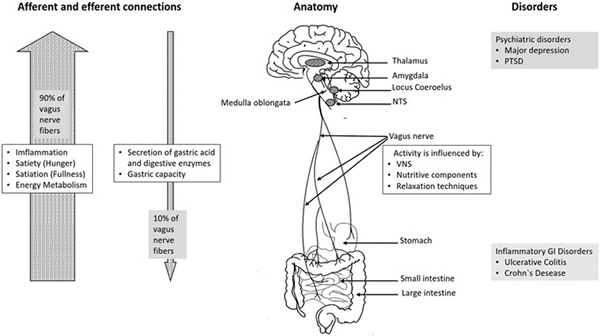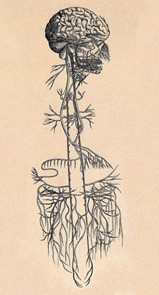Positive Health Online
Your Country

Emotion in the Body - The Vagus Nerve
listed in bodywork, originally published in issue 270 - May 2021
In my last article “Physical and Emotional Holding Patterns” I said that I would explore further how emotion manifests in the tissues of the body, particularly the viscera. As a bodywork practitioner of 28 years, I have witnessed how our physiology holds our life’s story in memories and bodily sensations. My experience shows me quite simply that our emotion is held in the body; there are multiple reasons for this. In this article I am going to explore the role of the Vagus Nerve and how it conveys emotion or “gut instincts” to the brain.
The Vagus nerve, otherwise known as the “vagrant or wandering nerve”, has multiple branches that emerge from the medulla oblongata, through the jugular foramen. The vagus separates and wanders from here to the concha of the ear, muscles of the larynx, the lungs and heart, as well as innervating greater parts of the digestive tract and other abdominal organs along the way. The vagus nerve has masses of nerve tissue that transmit sensory impulses back to the brain via two sensory ganglia. In brief the vagus is responsible for the regulation of internal organ functions, such as digestion, heart and respiratory rate, vasomotor activity and some reflex actions for example coughing, sneezing, swallowing and vomiting. The inner organs, particularly the gut with its huge surface area, are a major source of sensory information to the brain.

The Vagus Nerve by Nichole R. Fuller
The vagus and parasympathetic function: the vagus is the main contributor to the parasympathetic nervous system, with the most important function being afferent; transmitting information from the organs, gut, heart and lungs to the brain to be interpreted.
We instinctively know this; as we have all witnessed how our own body physiology reacts when we find ourselves in a very stressful situation, or when we are scared of an up-coming event. Even just recalling a difficult time in our lives may create symptoms. These symptoms may include a racing heart, shallow breath, high voice or even a disrupted digestive system (all of these tissues and organs have vagal innervation). There are many phases in the English language that refer to these type of fearful body sensations; “my heart missed a beat”, “my stomach was in my mouth”, “I had butterflies”, “my stomach was in knots”, “I could not catch my breath”. These felt sensations are in fact due to physiological responses in the viscera that are transmitted back to the brain for interpretation -conveying what could be called “gut feelings” or “instincts” to the brain.
A fascinating new study, entitled “Gut Vagal Afferents Differentially Modulate Innate Anxiety and Learned Fear”[1] shows research from ETH Zurich which has identified how “gut instincts” reach the brain via the vagus nerve and are linked to different fear and anxiety responses.
The Vagus Nerve is a two-way super highway, known as the “brain-gut axis”. Efferent nerves send messages out from the brain to the viscera and peripheral body, whist afferent nerves send messages from the periphery back to the brain. Up to 90 % of the nerve fibres in the vagus nerve are afferent, dedicated to communicating the state of your viscera – through sensations - back to the brain for interpretation. Therefore disruption in vagal activity plays a role in major psychiatric conditions, such as regulating mood, as well as fear and anxiety states and PTSD. Increased vagal activation, will be interpreted by the brain as bad; causing us anxiety, keeping us in an alert state or stimulating the fight or flight response.

An illustration showing some of the anatomy and functions of the Vagus nerve.[2]
- On the left: illustrating 90% of vagal nerve fibres are afferent (transmitting message to the brain);
- In the middle: an illustration of the anatomy of the Vagus nerve and how it is influenced;
- On the right: psychiatric disorders influenced by vagal activation.
Feedback loop. With this mind-body feedback loop, messages are transmitted downstream from your brain and conscious mind via efferent branches of the vagus nerve, as well as up-stream. In his study Urs Meyers, who conducted the research on rats, snipped the afferent nerve fibres of the vagus, going from gut to brain, by doing so turned the two-way highway into a one-way street – preventing the brain from receiving messages from the gut. This allowed the researchers to look at the role the vagus plays in conveying gut instincts to the brain. Without the two-way communication of the vagus nerve between brain and gut rats showed a lower level of innate fear. Researchers concluded that an innate response to fear appears to be influenced significantly by “gut instinct” signals, sent form gut to brain.
Urs Meyers who conducted the research in ETH Zurich concluded,
"We were able to show for the first time that the selective interruption of the signal path from the stomach to the brain changed complex behavioural patterns. This has traditionally been attributed to the brain alone. The study shows clearly that the stomach also has a say in how we respond to fear.”
It is therefore clear that the Vagus Nerve has powerful psychological influences on health and the restoration of health.
What can we as Bodywork Therapists do to Facilitate Down Regulation of the Vagus Nerve?
My clinical experience has shown me that if we can create a really safe holding field, where we are truly grounded and present and if we listen with real compassion and presence, clients begin to feel safe and can begin to down regulate. As illustrated above, by reducing visceral vagal activation and by encouraging our clients to take long slow breaths, we begin to signal to the brain that we are safe; this simple exercise may be comforting, before coming into further techniques.

The vagus nerve wandering down the lateral neck to the viscera
Techniques: There are a great many techniques that would facilitate down regulating vagal activity, I am going to suggest two. The vagus nerve exits the skull through the jugular foramen, before journeying south along the lateral neck on its journey to the viscera as mentioned above. The first technique will access the beginning of the vagus, the second technique the lower portion.

The Cervical Cradle Hold
The Cervical Cradle Hold: By gently cradling the neck, in the palm of your soft, responsive hand (fingers one side and thumb the other) you can connect with the fascial tissue surrounding the vagus as it travels south. Allow your hand to soften and the neck will respond by dropping into your hand. If there is increased cervical muscle tone stimulating the vagus, your sustained contact will allow the fascial tissue to soften. The Vagus will also down regulate in response to your own nervous system, so ensure as a therapist that you are well resourced before commencing any treatment. This subtle yet incredibly powerful technique will assist the client in down regulating; with the client in supine you will witness their breathing change, perhaps witness the jaw dropping and a softening of facial features - indicating to you, the profound efficacy of this technique. At the end of the treatment, you may notice the tone of voice has changed.

Abdominal Hold
Abdominal Hold: The second is a simple yet powerful technique, where we contact the abdomen. Our “underbelly”, as we have seen, contains many of our viscera, is served by the vagus, and therefore holds our “gut instincts”: be mindful that this can be a sensitive, vulnerable area. You can apply this technique in supine or prone, the advantage of prone is that the underbelly will literally drop into you hand(s) as the body lets go. The advantage of supine is that you can observe facial features. Place one or both hands on the belly, ensure they are soft, responsive and contouring the body, connect with your clients fascial system and simply wait. Allow the clients fascial system to respond to your touch, be responsive to any changes. Again the vagus will regulate with your nervous system.
By applying both of these simple, yet powerful techniques you will be accessing the full length of the vagus nerve. Be observant: notice the changes in voice, breathing, heart rate, visual expression, jaw clenching, cervical muscle tone and more.
To Conclude: The viscera, particularly those served by the vagus nerve, transmit emotions, or “gut-instincts” back to the brain where they are interpreted. Healthy vagal communication between gut and brain can help to slow you down, this is likened to putting the car brakes on (something that in our hectic modern lives we all need at times). The neuro transmitter’s acetylcholine and GABA lower heart rate and blood pressure, which helps promote parasympathetic activity, enabling your heart and organs slow down and therefore facilitating a rest and digest state. Something which I would say all clients need. Clients usually seek our help in times of stress, as all symptoms are exacerbated.
By consciously resting, receiving therapeutic treatment, or taking slow deep breaths for example we can change and down regulate vagal input from viscera to brain, which will be interpreted as a sign of safety, or a time to “rest and digest”. This creates an inner calm, which is essential for homeostasis and health. As an experienced bodywork practitioner, I have repeatedly witnessed this, but now research has shown this to be true. As bodywork practitioners we are fortunately well served to be able to help our clients with this understanding and by the simple, yet skilful use of our hands. Gentle, therapeutic fascia informed bodywork or massage techniques, as demonstrated above can facilitate down regulation of vagal activity, reducing fear and anxiety states. We explore this further in many of our workshops, including our Tinnitus & Migraine workshop.
References
- Gut Vagal Afferents Differentially Modulate Innate Anxiety and Learned Fear” published May 21, 2014 in the Journal of Neuroscience.
- www.frontiersin.org
Comments:
-
No Article Comments available